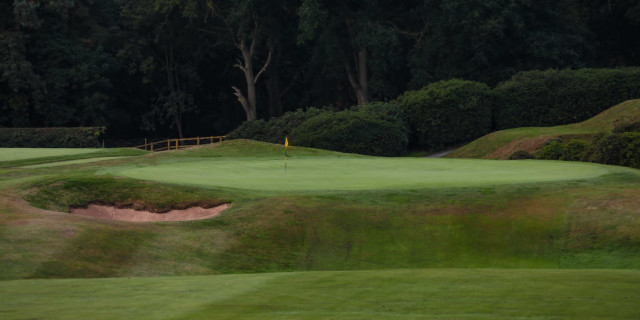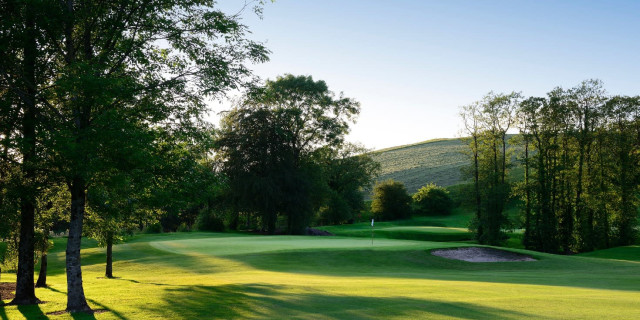Delamere Forest Golf Club Feature Review
There are few courses with such book-ended appeal as Delamere Forest in Cheshire.
A day starts here with a mouthwatering panoramic view from the clubhouse terrace over the rolling fairways rising on the hillside and concludes with an equally jaw-dropping view down the hill from the 18th tee and fairway.
It’s a fitting finale to a course that many will treasure for its quality, visual appeal and variety.
Designed by Herbert Fowler in 1910 on sandy soil shaped by retreating seas and glaciers from the Ice Age the course makes the most of nature’s legacy.
Set up by local businesspeople to provide a recreational outlet on former hunting grounds it is host to many prestigious amateur county and national competitions.
Like most courses it was subject to alterations over the years yet restored to its original Fowler design following a renovation programme under the guidance of Tom MacKenzie which produced enlarged greens, run off areas and restored bunkers.

Work will soon begin on the installation of a new irrigation system which will be completed by 2023.
Despite its location in the heart England’s largest forest, the trees are more of a pleasant backdrop to what is really a classic heathland course. The rolling fairways are lined by fescue rough and small clumps of heather producing a typical heathland appearance.
The clubhouse is traditional in style, extremely welcoming and features a large patio area with those superb views over the course.
The Front Nine

The course climbs up the hillside from the first two tees making for a rather long and taxing start before dropping down towards the clubhouse on the third where a drive down the left-hand side is the preferred shot.
Golfers then come across the first of the four long par 3s; this, the 4th hole, is the longest and the toughest with a big hit required to a green which is difficult to find. A miss right sees the ball scoot down a slope away from the green, whilst the best line to the left is guarded by a menacing pot bunker.
The 5th, stroke index 2, is arguably the toughest hole on the course - a dog-leg left to a green with a narrow opening.
Players reach the highest point of the course by the sixth tee which offers a splendid view over a deep pond to the left of the green.
The 9th is a fun hole if you play it well but will frustrate players who misjudge their tee shots from an elevated tee to a plateau landing area. The approach to the elevated green needs great accuracy from any angle.
The Back Nine

After a tough opening half there appears to be little respite from the 10th tee, although this hole plays shorter than it looks. The return is in fact over 200 yards shorter than the front nine, but it doesn’t play any easier as it features par fours where the need for precision is a must. This is typified by the 14th, the first of two consecutive holes that would grace any golf course. At 366 yards this ought to be straightforward, but you really must seek out the right hand side of the fairway or the ball will run off into a long ditch, partly excavated by a Luftwaffe aircraft dropping its remaining payload over the course on the way from a raid over Liverpool during the Second World War.
The green stands on a plateau placed on a bankside in front of the coniferous forest rising behind. It pays to read the pros tips on the club website before you line up here. The line, from any position, is the lone silver birch standing behind the green.
The next hole, which benefitted from widening of the fairway in the MacKenzie project is a lovely hole passing a pretty pond. Another dog-leg left; it required a fairway wood at the most off the tee followed by a short iron into an elevated green.
The routing then takes players back to the top of the course where another dauntingly long 3 three awaits, before descending back towards the clubhouse via a straightforward 17th.
There is nothing straightforward about the fabulous 18th hole. Players need to drive from an elevated tee over a clump of pines to the fairway below. Big hitters will fancy shaving distance by taking on a long carry down to right but wherever a well struck ball lands, players are faced with a decision between going for it in two, aiming to avoid the marshy area short left of the hole or laying up and leaving a short shot to the undulating green.
A great hole made better by the stunning view of the clubhouse as you meander down the fairway. A fitting end to an enjoyable experience.
Verdict

An excellent, challenging course with a slope rating of 134 off the green tees is not for the beginner but will please all seasoned players who like a wide variety of holes in an uncrowded, scenic environment. Playable throughout the year due to its sandy soil, it is easy to see why this course is widely rated as among the very finest courses in Cheshire and a wise choice for the many prestigious championships held there. Well worth a visit.
Related Content: travel review Golf Courses England Courses
What do you think? post your thoughts and feedback on the Golfshake Forum: https://forum.golfshake.com/

















